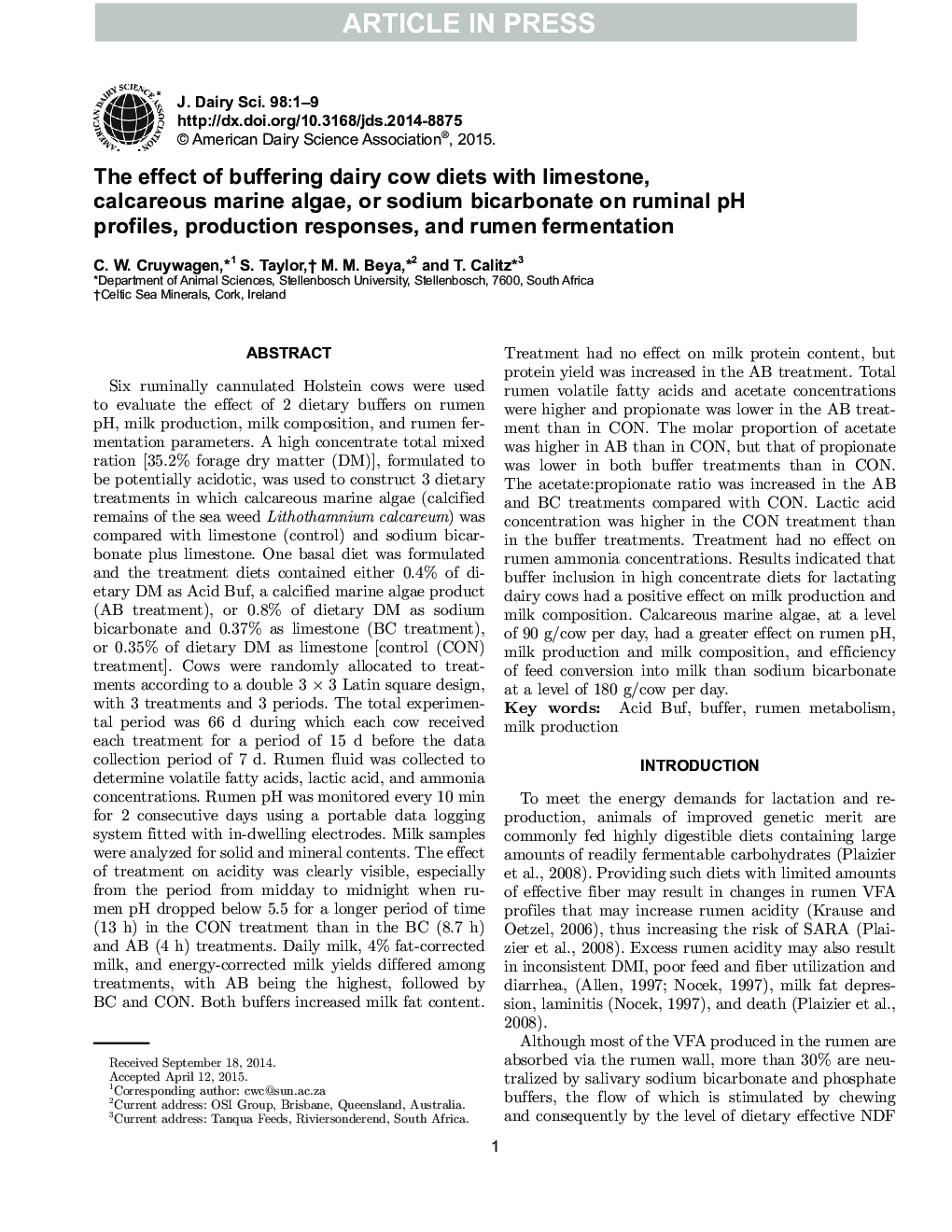| کد مقاله | کد نشریه | سال انتشار | مقاله انگلیسی | نسخه تمام متن |
|---|---|---|---|---|
| 10974234 | 1108023 | 2015 | 9 صفحه PDF | دانلود رایگان |
عنوان انگلیسی مقاله ISI
The effect of buffering dairy cow diets with limestone, calcareous marine algae, or sodium bicarbonate on ruminal pH profiles, production responses, and rumen fermentation
ترجمه فارسی عنوان
تاثیر جیره گاوهای لاغر با آهک، جلبکهای آهکی ساحلی یا بی کربنات سدیم بر روی پروتئین های شیمیایی، پاسخ های تولید و تخمیری شکمبه
دانلود مقاله + سفارش ترجمه
دانلود مقاله ISI انگلیسی
رایگان برای ایرانیان
کلمات کلیدی
اسید بوف، بافر، متابولیسم شکم تولید شیر،
موضوعات مرتبط
علوم زیستی و بیوفناوری
علوم کشاورزی و بیولوژیک
علوم دامی و جانورشناسی
چکیده انگلیسی
Six ruminally cannulated Holstein cows were used to evaluate the effect of 2 dietary buffers on rumen pH, milk production, milk composition, and rumen fermentation parameters. A high concentrate total mixed ration [35.2% forage dry matter (DM)], formulated to be potentially acidotic, was used to construct 3 dietary treatments in which calcareous marine algae (calcified remains of the seaweed Lithothamnium calcareum) was compared with limestone (control) and sodium bicarbonate plus limestone. One basal diet was formulated and the treatment diets contained either 0.4% of dietary DM as Acid Buf, a calcified marine algae product (AB treatment), or 0.8% of dietary DM as sodium bicarbonate and 0.37% as limestone (BC treatment), or 0.35% of dietary DM as limestone [control (CON) treatment]. Cows were randomly allocated to treatments according to a double 3Â ÃÂ 3 Latin square design, with 3 treatments and 3 periods. The total experimental period was 66 d during which each cow received each treatment for a period of 15 d before the data collection period of 7 d. Rumen fluid was collected to determine volatile fatty acids, lactic acid, and ammonia concentrations. Rumen pH was monitored every 10Â min for 2 consecutive days using a portable data logging system fitted with in-dwelling electrodes. Milk samples were analyzed for solid and mineral contents. The effect of treatment on acidity was clearly visible, especially from the period from midday to midnight when rumen pH dropped below 5.5 for a longer period of time (13 h) in the CON treatment than in the BC (8.7 h) and AB (4 h) treatments. Daily milk, 4% fat-corrected milk, and energy-corrected milk yields differed among treatments, with AB being the highest, followed by BC and CON. Both buffers increased milk fat content. Treatment had no effect on milk protein content, but protein yield was increased in the AB treatment. Total rumen volatile fatty acids and acetate concentrations were higher and propionate was lower in the AB treatment than in CON. The molar proportion of acetate was higher in AB than in CON, but that of propionate was lower in both buffer treatments than in CON. The acetate:propionate ratio was increased in the AB and BC treatments compared with CON. Lactic acid concentration was higher in the CON treatment than in the buffer treatments. Treatment had no effect on rumen ammonia concentrations. Results indicated that buffer inclusion in high concentrate diets for lactating dairy cows had a positive effect on milk production and milk composition. Calcareous marine algae, at a level of 90 g/cow per day, had a greater effect on rumen pH, milk production and milk composition, and efficiency of feed conversion into milk than sodium bicarbonate at a level of 180 g/cow per day.
ناشر
Database: Elsevier - ScienceDirect (ساینس دایرکت)
Journal: Journal of Dairy Science - Volume 98, Issue 8, August 2015, Pages 5506-5514
Journal: Journal of Dairy Science - Volume 98, Issue 8, August 2015, Pages 5506-5514
نویسندگان
C.W. Cruywagen, S. Taylor, M.M. Beya, T. Calitz,
